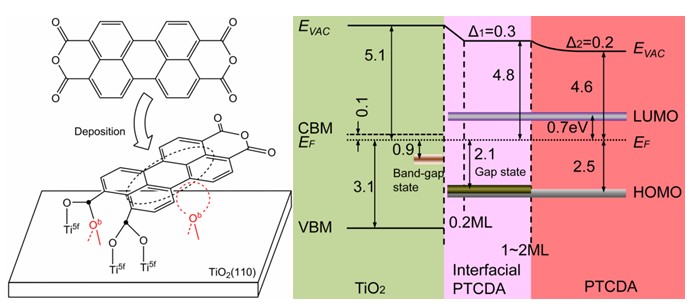Studies on the Structure and Charge Transfer Dynamics at the interfaces of PTCDA with Inorganic Substrates
Organic semiconductors have attracted widespread interests due to their promising applications in organic light emission diodes (OLED), field emission transistors (OFET), photovoltaic cells (OPVC) and dye sensitized solar cells (DSSC). In these devices, the molecular orientation, interfacial coupling and their influence on charge transfer dynamics are of critical importance for efficient solar energy conversion. Ultrafast charge transfer at the organic/substrate interfaces is necessary to compete effectively against various loss processes.
Based On synchrotron radiation photoemission spectroscopy (SRPES), near edge X-ray absorption structure (NEXAFS) and core-hole clock implementation of resonant photoemission spectroscopy (RPES), a systematic method has been established, which can be used to study the chemical interaction, the interfacial structure and charge transfer dynamics at the interface of organic materials with inorganic substrates. The core-hole clock spectroscopy is a new technique which has been successfully utilized to probe the ultrafast charge transfer dynamics at organic/inorganic interfaces with the timescale of several fs using the core-hole lifetime as an internal reference clock.
Firstly, the Surface Science group in our laboratory had investigated the interaction and charge transfer dynamics at the PTCDA/Au(111) interface using the newly developed method (J. Chem. Phys. 2011, 135: 174701). It was found that the charge transfer timescale at the PTCDA/Au(111) interface is much larger than the C 1s core-hole lifetime of 6 fs, indicating weak electronic coupling between PTCDA and the gold substrate due to the absence of chemical interaction and/or bonding. It turns out that gold may not be an ideal electrode. Therefore, a more active substrate-TiO2 was selected as substrate to improve interfacial electronic coupling. As expected, PTCDA molecules strongly reacted with TiO2 surface: the anhydride terminal groups (O=C-O-C=O) react with the TiO2 surface through the ring opening from the C-O-C bonds, which then covalently bond to the five-fold coordinated Ti (Ti5f) atoms and the adjacent bridging oxygen (Ob) atoms on the TiO2 surface by forming C-O-Ti bonds, and the perylene cores are attached to the Ob on the TiO2 surface. The transformation of thickness dependent molecular orientation from slightly tilting at 0.5 ML, disordered at 1 ML and lying-down at 28 ML was observed by angular dependent NEXAFS due to the proposed interfacial chemical interactions. The understanding of the interfacial interactions and electronic structure at the PTCDA/TiO2 interface may have important implications for developing PTCDA based DSSC devices. In particular, the strong electronic coupling and the relative energy level alignment at the interface facilitate the interfacial charge delocalization and are beneficial for the device performance. The research results about electronic coupling and molecular orientation have been published in The Journal of Physical Chemistry C (2011, 115: 24880).
 Schematic diagram of chemical interactions and energy level alignment for PTCDA molecules on TiO2(110).
Schematic diagram of chemical interactions and energy level alignment for PTCDA molecules on TiO2(110).
QQ截图20131115164820.jpg
Back

